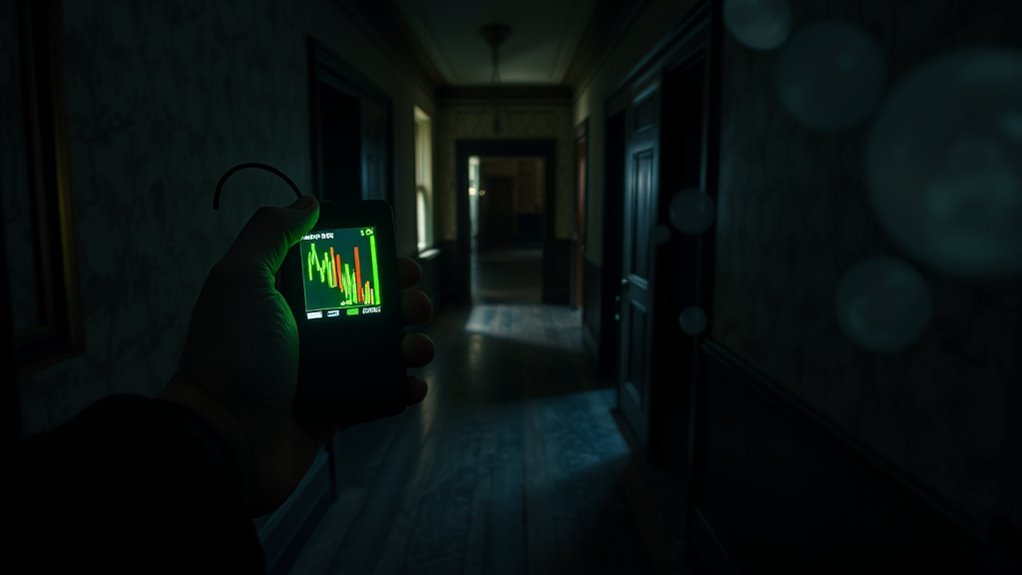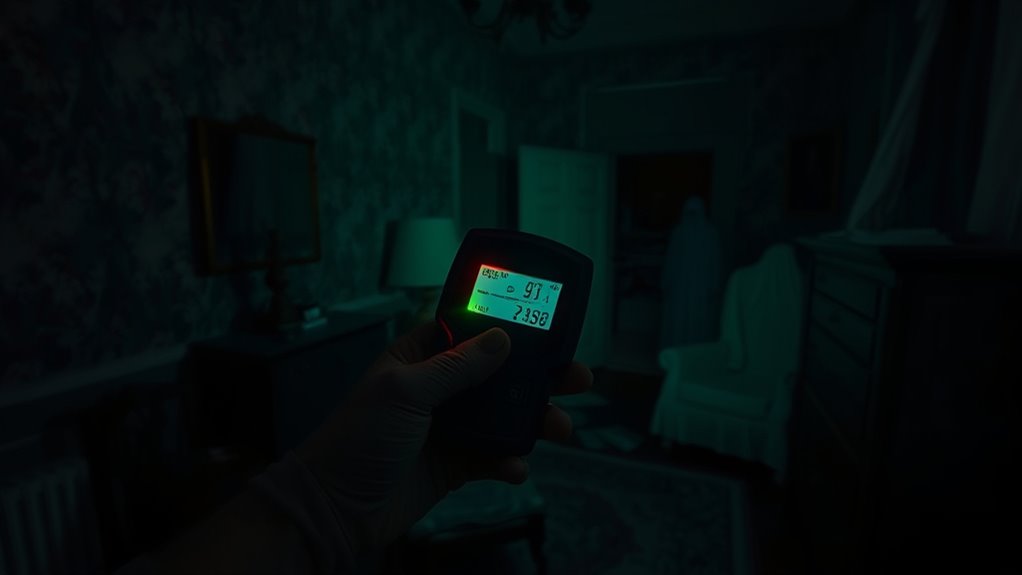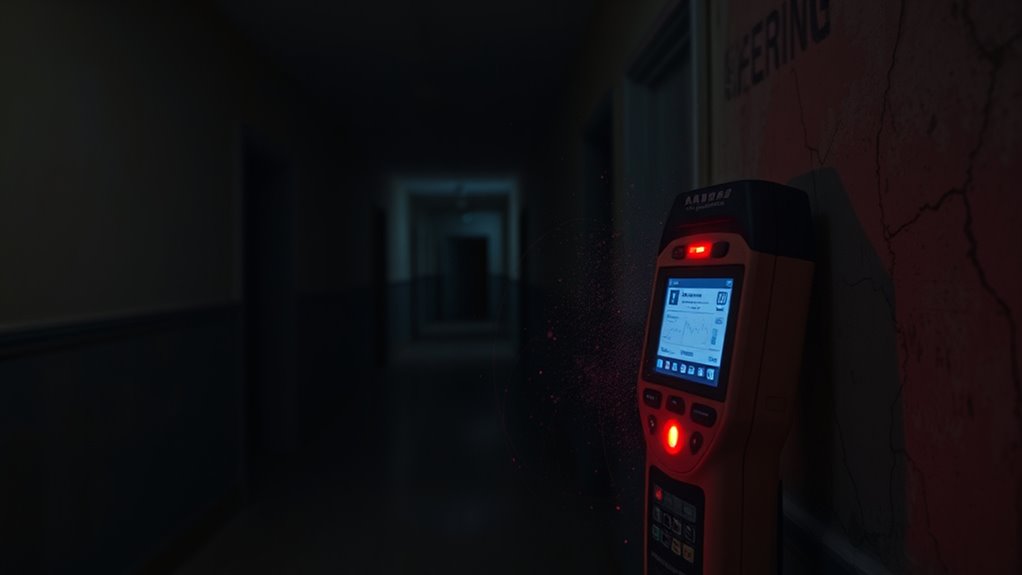When chasing EMF ghosts, you’ll use detectors to find electromagnetic fluctuations that stand out from normal environmental sources like wiring or electronics. It’s essential to calibrate your device and keep in mind that many anomalies are false positives caused by everyday interference. Focus on patterns and repeat measurements to identify genuine signals. To improve your success, learn how to properly handle your equipment and interpret findings—if you keep exploring, you’ll discover more about effective ghost-hunting techniques.
Key Takeaways
- Calibrate EMF detectors properly and establish baseline readings to distinguish genuine anomalies from environmental noise.
- Move slowly and keep detectors steady, scanning various spots to identify consistent electromagnetic fluctuations.
- Cross-reference readings with environmental sources to avoid false positives caused by wiring or electronic devices.
- Look for sudden, isolated spikes that stand out from baseline and aren’t linked to known electrical activity.
- Document all readings, patterns, and environmental conditions to better interpret potential paranormal EMF activity.
How EMF Detectors Are Used in Paranormal Investigations

EMF detectors play a crucial role in paranormal investigations by helping investigators identify unusual electromagnetic activity that could indicate ghostly presence. When you use an EMF detector, you’re looking for electromagnetic interference that stands out from the normal background levels. To guarantee accurate readings, device calibration is essential; it helps you set a baseline and avoid false positives caused by natural electrical sources. Proper calibration involves adjusting the detector to known electromagnetic standards, which improves reliability during your hunt. Keep in mind that electromagnetic interference can come from various sources like electrical wiring, appliances, or nearby electronics. By understanding and controlling these factors, you enhance your chances of detecting genuine anomalies that might point to paranormal activity. Additionally, awareness of the best-rated pinball machines of 2024 can provide insights into how electromagnetic fields are generated and managed in different environments, helping you better interpret your EMF readings. Being knowledgeable about electromagnetic sources in your investigation area allows you to distinguish between natural and paranormal signals more effectively. Recognizing the source of electromagnetic interference helps minimize false alarms and improves the accuracy of your investigations. Incorporating EMF measurement techniques can further refine your ability to interpret potential paranormal signals accurately. Regularly updating your knowledge on electromagnetic interference trends can help you stay ahead of common false positives and improve your detection reliability.
Interpreting EMF Readings During a Ghost Hunt

Understanding how to interpret EMF readings is essential for distinguishing genuine paranormal activity from normal electrical interference. When you encounter electromagnetic anomalies, focus on patterns rather than isolated spikes. Consider these key factors:
- Sudden, brief spikes that appear without any obvious electrical source
- Consistent readings in specific areas that can’t be explained by wiring or appliances
- Fluctuations aligned with potential paranormal activity, such as unexplained sounds or movements
- Recognizing core personality traits can help you stay objective and avoid misinterpreting natural phenomena as paranormal signals. Additionally, being aware of electromagnetic interference sources helps in identifying environmental factors that may skew your readings. Understanding the impact of environmental conditions can further refine your interpretation process. Being familiar with asset division laws can also help you understand the legal implications if these phenomena are linked to property disputes or claims. Incorporating knowledge of famous paranormal cases can provide historical context that may influence your investigation approach.
Using effective paranormal research methods, you’ll learn to differentiate between natural causes and potential spirits. Remember, high EMF levels alone don’t confirm paranormal presence; you need context and consistency. Proper interpretation helps you avoid false positives and focus on readings that merit further investigation. Your understanding of these signals enhances your overall ghost-hunting accuracy.
Scientific Perspectives on EMF and Spirit Communication

Although many ghost hunters believe that electromagnetic fields can facilitate communication with spirits, scientific research remains cautious about this connection. Electromagnetic theory explains how EMF detectors measure fluctuations in electromagnetic energy, but it doesn’t support any direct link to paranormal activity. Experts in physics and psychology emphasize that EMF readings often result from natural sources, electrical devices, or environmental factors, not spirits. Paranormal skepticism highlights that correlation doesn’t imply causation, and fluctuating EMFs are easily misinterpreted. While some researchers explore potential biophysical interactions, current evidence doesn’t substantiate claims linking EMF anomalies to spirit communication. As a result, the scientific community remains skeptical, urging caution before attributing EMF readings during hunts to supernatural causes. Understanding electromagnetic phenomena helps clarify that many EMF fluctuations can be explained by environmental and technical factors rather than paranormal influences. Additionally, awareness of scientific limitations is crucial when interpreting paranormal-related EMF data, as natural sources are often responsible for these fluctuations. Recognizing interference sources further supports the need for cautious interpretation of EMF measurements in these contexts. Moreover, proper measurement techniques are essential to differentiate between genuine anomalies and technical artifacts.
Limitations and Challenges of Using EMF Detectors

While EMF detectors are popular tools in ghost hunting, they face significant limitations that can hinder their effectiveness. False positives are common, triggered by everyday electrical devices, wiring, or even natural sources like lightning. This makes it hard to distinguish genuine paranormal activity from environmental noise. Additionally, equipment calibration issues can lead to inconsistent readings, causing confusion or missed signals. As you use the device, imagine: 1. Detecting a spike that’s actually just your cellphone’s electromagnetic pulse. 2. Misinterpreting normal wiring fluctuations as supernatural phenomena. 3. Struggling with uncalibrated tools giving unreliable, fluctuating signals. Moreover, industry transformations such as AI automation and evolving technology can influence how these devices operate and are interpreted, emphasizing the importance of understanding their limitations. These challenges demand careful interpretation and awareness of environmental factors. Without understanding these limitations, you risk chasing false leads or dismissing real activity, reducing the overall effectiveness of your hunt.
Tips for Effective Use of EMF Devices in Haunted Locations

To get the most accurate readings, start by thoroughly familiarizing yourself with your EMF device’s manual and calibration procedures. Proper calibration techniques guarantee your device provides reliable data, so spend time calibrating it before each hunt. When it comes to device placement, position your EMF detector away from metal objects and electronic devices that could cause false readings. Hold the device steady and at consistent heights to maintain accuracy. Move slowly through haunted areas, pausing frequently to scan different spots carefully. Use a baseline reading in a known neutral area to compare against readings during investigation. Remember, consistent device placement and calibration are key to distinguishing genuine EMF anomalies from environmental noise.
Frequently Asked Questions
Can EMF Detectors Differentiate Between Natural and Paranormal Sources?
You might wonder if EMF detectors can tell the difference between natural and paranormal sources. While they detect electromagnetic interference from both, they can’t reliably distinguish between natural (like electrical wiring or environmental factors) and artificial or paranormal sources. You need to analyze patterns, context, and other evidence to make that distinction, as EMF readings alone can’t confirm whether an anomaly is caused by natural phenomena or something paranormal.
What Are the Best Brands of EMF Detectors for Ghost Hunting?
When choosing an EMF detector for ghost hunting, you want a device with high EMF detector accuracy and reliable paranormal detection capabilities. Brands like K-II and Mel Meter are popular because they offer sensitive, user-friendly models known for their reliability in detecting unusual EMF fluctuations. These detectors help you differentiate natural from paranormal sources, ensuring your investigations have better accuracy and consistency.
How Do Environmental Factors Affect EMF Readings During Investigations?
Environmental factors like electromagnetic interference and weather condition effects can substantially impact your EMF readings during investigations. You might notice false positives or fluctuating signals when nearby electronics, power lines, or metal objects are present. Weather changes, such as storms or humidity, can also distort readings. To get accurate results, make certain you’re in a controlled environment, away from sources of electromagnetic interference, and consider weather conditions before interpreting your EMF detector data.
Is There Scientific Proof Linking EMF Spikes to Paranormal Activity?
You might wonder if EMF spikes truly indicate paranormal activity, but scientific skepticism reminds you that current evidence doesn’t confirm a direct link. Electromagnetic theory shows that many natural and man-made sources can cause these fluctuations. You should remain cautious, understanding that while EMF detectors can suggest anomalies, they don’t provide conclusive proof of ghosts. Always consider environmental factors and scientific explanations before jumping to paranormal conclusions.
How Often Should EMF Detectors Be Calibrated for Accurate Readings?
You should calibrate your EMF detectors regularly to guarantee accurate readings. The ideal calibration frequency depends on your usage and device quality, but generally, it’s recommended every 6 to 12 months. Incorporate routine maintenance routines, like checking for firmware updates and inspecting the device for damage. Consistent calibration helps maintain reliability, so you can confidently interpret EMF spikes during your hunts.
Conclusion
Remember, while EMF detectors might seem to chase ghosts, they’re really just tools in your hands. Don’t let false readings or misunderstood signals scare you into believing in supernatural spirits. Instead, see them as a mirror reflecting your curiosity and courage to explore the unknown. Every beep and flicker is a reminder that the real mystery lies within your willingness to seek the truth, no matter how elusive or extraordinary it may seem.









